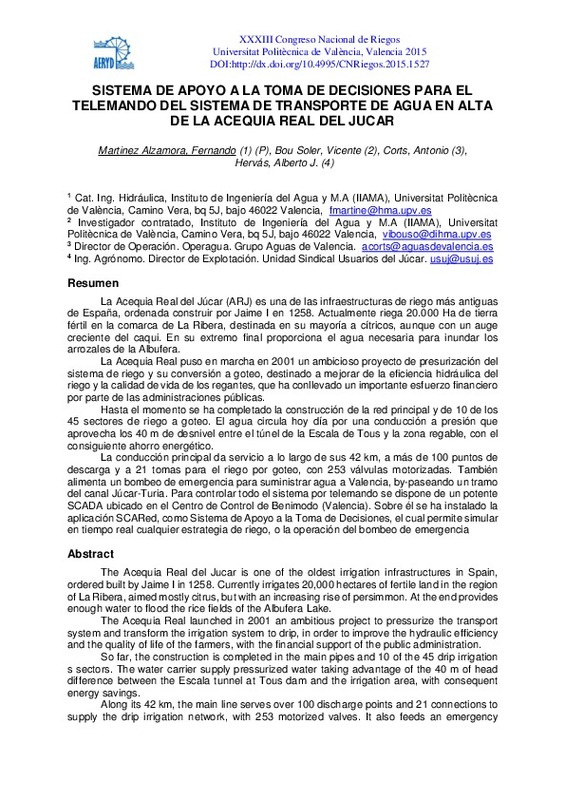JavaScript is disabled for your browser. Some features of this site may not work without it.
Buscar en RiuNet
Listar
Mi cuenta
Estadísticas
Ayuda RiuNet
Admin. UPV
SISTEMA DE APOYO A LA TOMA DE DECISIONES PARA EL TELEMANDO DEL SISTEMA DE TRANSPORTE DE AGUA EN ALTA DE LA ACEQUIA REAL DEL JUCAR
Mostrar el registro sencillo del ítem
Ficheros en el ítem
| dc.contributor.author | Martínez Alzamora, Fernando
|
es_ES |
| dc.contributor.author | Bou Soler, Vicente
|
es_ES |
| dc.contributor.author | Corts, Antonio
|
es_ES |
| dc.contributor.author | Hervás, Alberto
|
es_ES |
| dc.date.accessioned | 2018-03-01T11:14:17Z | |
| dc.date.available | 2018-03-01T11:14:17Z | |
| dc.date.issued | 2015-06-15 | |
| dc.identifier.isbn | 9788490483749 | |
| dc.identifier.uri | http://hdl.handle.net/10251/98687 | |
| dc.description.abstract | [EN] The Acequia Real del Jucar is one of the oldest irrigation infrastructures in Spain, ordered built by Jaime I in 1258. Currently irrigates 20,000 hectares of fertile land in the region of La Ribera, aimed mostly citrus, but with an increasing rise of persimmon. At the end provides enough water to flood the rice fields of the Albufera Lake. The Acequia Real launched in 2001 an ambitious project to pressurize the transport system and transform the irrigation system to drip, in order to improve the hydraulic efficiency and the quality of life of the farmers, with the financial support of the public administration. So far, the construction is completed in the main pipes and 10 of the 45 drip irrigation s sectors. The water carrier supply pressurized water taking advantage of the 40 m of head difference between the Escala tunnel at Tous dam and the irrigation area, with consequent energy savings. Along its 42 km, the main line serves over 100 discharge points and 21 connections to supply the drip irrigation network, with 253 motorized valves. It also feeds an emergency pumping to supply water to Valencia, bypassing a stretch of the Júcar-Turia canal. To control remotely the entire system there is installed a powerful SCADA system located in the Control Center of Benimodo (Valencia). Scared application works at the same place as a Decision Support System (DSS) fed from the SCADA data, which allows simulating in real time any irrigation strategy, or the operation of the emergency pumping | es_ES |
| dc.description.abstract | [ES] La Acequia Real del Júcar (ARJ) es una de las infraestructuras de riego más antiguas de España, ordenada construir por Jaime I en 1258. Actualmente riega 20.000 Ha de tierra fértil en la comarca de La Ribera, destinada en su mayoría a cítricos, aunque con un auge creciente del caqui. En su extremo final proporciona el agua necesaria para inundar los arrozales de la Albufera. La Acequia Real puso en marcha en 2001 un ambicioso proyecto de presurización del sistema de riego y su conversión a goteo, destinado a mejorar de la eficiencia hidráulica del riego y la calidad de vida de los regantes, que ha conllevado un importante esfuerzo financiero por parte de las administraciones públicas. Hasta el momento se ha completado la construcción de la red principal y de 10 de los 45 sectores de riego a goteo. El agua circula hoy día por una conducción a presión que aprovecha los 40 m de desnivel entre el túnel de la Escala de Tous y la zona regable, con el consiguiente ahorro energético. La conducción principal da servicio a lo largo de sus 42 km, a más de 100 puntos de descarga y a 21 tomas para el riego por goteo, con 253 válvulas motorizadas. También alimenta un bombeo de emergencia para suministrar agua a Valencia, by-paseando un tramo del canal Júcar-Turia. Para controlar todo el sistema por telemando se dispone de un potente SCADA ubicado en el Centro de Control de Benimodo (Valencia). Sobre él se ha instalado la aplicación SCARed, como Sistema de Apoyo a la Toma de Decisiones, el cual permite simular en tiempo real cualquier estrategia de riego, o la operación del bombeo de emergencia | es_ES |
| dc.format.extent | 11 | es_ES |
| dc.language | Español | es_ES |
| dc.publisher | Editorial Universitat Politècnica de València | es_ES |
| dc.relation.ispartof | XXXIII CONGRESO NACIONAL DE RIEGOS. Valencia 16-18 junio de 2015 | es_ES |
| dc.rights | Reconocimiento - No comercial - Sin obra derivada (by-nc-nd) | es_ES |
| dc.subject | Congreso Nacional de Riegos | es_ES |
| dc.subject.classification | INGENIERIA HIDRAULICA | es_ES |
| dc.title | SISTEMA DE APOYO A LA TOMA DE DECISIONES PARA EL TELEMANDO DEL SISTEMA DE TRANSPORTE DE AGUA EN ALTA DE LA ACEQUIA REAL DEL JUCAR | es_ES |
| dc.type | Capítulo de libro | es_ES |
| dc.type | Comunicación en congreso | es_ES |
| dc.identifier.doi | 10.4995/CNRiegos.2015.1527 | |
| dc.rights.accessRights | Abierto | es_ES |
| dc.contributor.affiliation | Universitat Politècnica de València. Departamento de Ingeniería Hidráulica y Medio Ambiente - Departament d'Enginyeria Hidràulica i Medi Ambient | es_ES |
| dc.contributor.affiliation | Universitat Politècnica de València. Escuela Técnica Superior de Ingenieros Industriales - Escola Tècnica Superior d'Enginyers Industrials | es_ES |
| dc.contributor.affiliation | Universitat Politècnica de València. Instituto Universitario de Ingeniería del Agua y del Medio Ambiente - Institut Universitari d'Enginyeria de l'Aigua i Medi Ambient | es_ES |
| dc.description.bibliographicCitation | Martínez Alzamora, F.; Bou Soler, V.; Corts, A.; Hervás, A. (2015). SISTEMA DE APOYO A LA TOMA DE DECISIONES PARA EL TELEMANDO DEL SISTEMA DE TRANSPORTE DE AGUA EN ALTA DE LA ACEQUIA REAL DEL JUCAR. En XXXIII CONGRESO NACIONAL DE RIEGOS. Valencia 16-18 junio de 2015. Editorial Universitat Politècnica de València. https://doi.org/10.4995/CNRiegos.2015.1527 | es_ES |
| dc.description.accrualMethod | OCS | es_ES |
| dc.relation.conferencename | XXXIII Congreso Nacional de Riegos | es_ES |
| dc.relation.conferencedate | June 16-18,2015 | es_ES |
| dc.relation.conferenceplace | Valencia, Spain | es_ES |
| dc.relation.publisherversion | http://ocs.editorial.upv.es/index.php/CNRiegos/CNRiegos33/paper/view/1527 | es_ES |
| dc.type.version | info:eu-repo/semantics/publishedVersion | es_ES |
| dc.relation.pasarela | OCS\1527 | es_ES |








